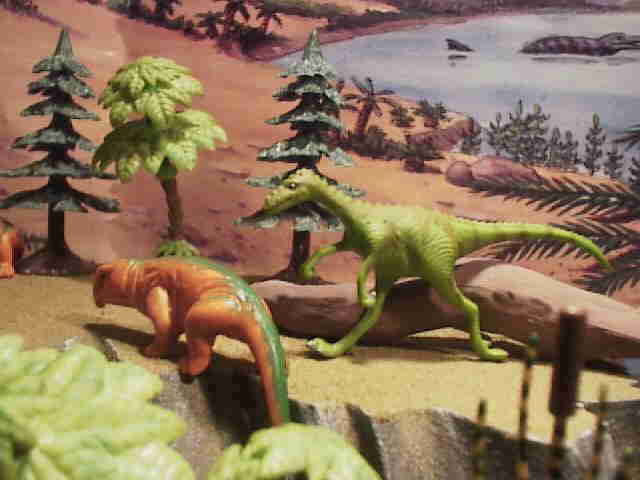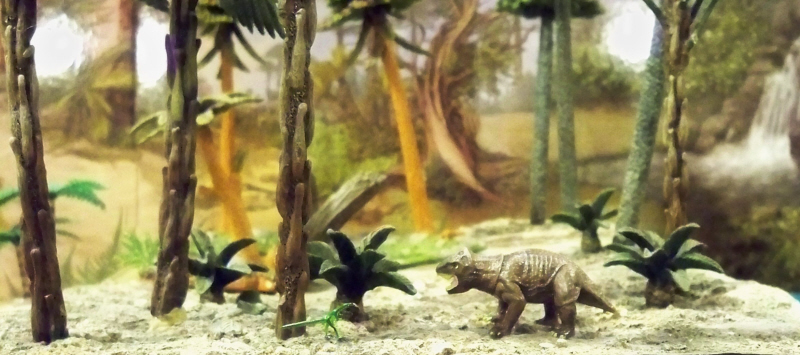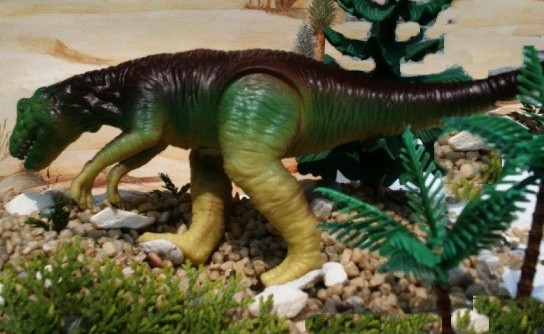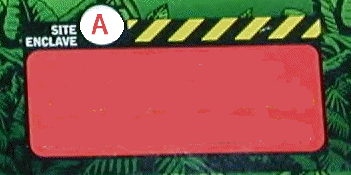LATE TRIASSIC CARNIAN AGE
South America Ischigualasto
227 to 221 million years ago, the Carnian is dominated by big dicynodonts, medium size rhynchosaurs and medium traversodonts. Kanneymeriid dicynodonts, are the big herbivores. They are reduced in diversity, with only one species found in each local fauna. The most common is the tusked Placerias. Traversodontid cynodonts were medium size plant eaters descended from the carnivorous cynodonts. Aetoesaurs are medium size herbivores important in some locations a preview of the armored dinosaurs to come. Temnospondyl amphibians are wide spread. Phytosaurs, rauisuchids, postosuchids ornithosuchids, and early theropod dinosaurs are the top carnivores. Trhough the Late Triassic Carnian and Early Jurassic cycadoids or bennettities are the characteristic plants and other conifers are wide spread. Cycadoids are generally medium to low in height they are thought to be slow growing with foliage high in toxins and generally of low food value. Superficially cycadoids resemble cycads which become more common later in the Jurassic declining in the Cretaceous but still surviving today. Some are slender with branching trunks like modern palm trees to which they are not closely related. Others look like pinecones or pineapples with leaves on top. Older Paleozoic flora like the giant club Moss and horsetails still are present in wet areas but they steadily decline and primitive conifers and ferns are wide spread.
Updated 091612
The Ischigualasto Formation contains some of the oldest known dinosaur remains. In the Carnian this area was a volcanically active floodplain dominated by rivers and had a strongly seasonal rainfall. Petrified tree trunks of Protojuniperoxylon ischigualastianus more than 131 ft tall attest to a rich vegetation at that time that inlcuded ferns and horsetails.

Rhynchosaurs had beak-like mouths that they would have used to lop the tough plants of the Triassic, probably seed ferns. There at least two pulses of dinosaurs at the end of the Triassic. Staurikosaurus (Southern Cross reptile) was small and agile dinosaur with a slim body, a long, slender tail, sprinter's legs, and shins longer than its thighs. Its head was large for its size, with sharp flesh-eater's teeth. It probably had short arms with 5 fingered hands, and also 5 toes and is related to the larger Herrerasaurus. Eoraptor, a small predator is considered the most primitive dinosaur known.
Rhynchosaurs looked like big buck toothed lizards designed to gnaw tough vegetation. Hyperodepedon was an advanced form. They were an important group of herbivores but died out during the Late Triassic mass extinction.
Ischigualastia, was a Kanneymeriid dicynodonts, larger than the later Placerias. The large herbivore was up to 11.5 ft and weighed one to two tons (1.1 to 2.2 short tons). Unlike Placerias, it lacked tusks.
The large carnivore Saurosuchus (meaning "lizard crocodile") was a rauisuchian archosaur. Is was one of the largest rauisuchians. The size estimates range from around (20 to 30 ft) in total body length. It is an apex predator.
/>
The ornithosuchids, Venaticosuchus and Riojasuchus were around 4 metres (13 ft) in length it belongs to the same family as Ornithosuchus. There are five toes on each foot and a double row of armoured plates along the animal's back.
 |
|
| A large carnivore Herresaurus was the first big theropod at 10 feet. Herrerasaurus may have lived in upland forest areas with seasonal climate, preying on the early plant eating dinosaur Pisanosaurus and rhychosaurs. | Herrerasaurus is a very odd theropod and at one time was consider to be too primitive to be classified in the same family with later carnivores. Now is is thought to an early side branch of the theropod family that died out. |
Dinosaurs are neither the most numerous, nor the largest animals from Ischigualasto. Dinosaurs at this time only make up only about 6% of all tetrapod's and have few species. They diversify in the following Norian after an extinction that clears out the top predators.
